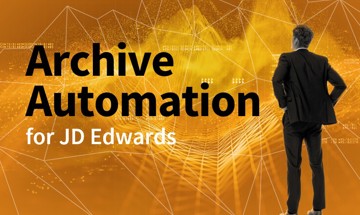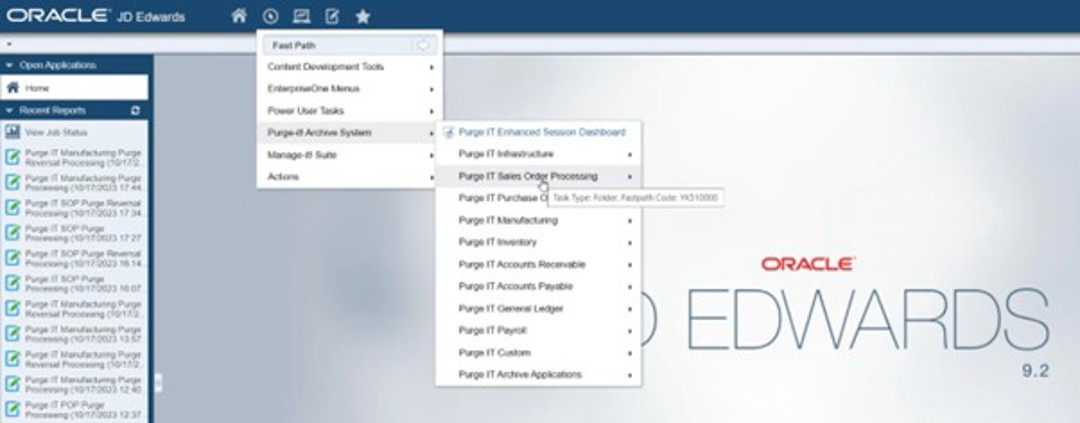
The year in review
Looking back on 2025 milestones and ahead to more JD Edwards in 2026!
Read more >
How do you manage JD Edwards data without JD Edwards?
As your JD Edwards system is retired you may start to lose JD Edwards skills and knowledge. Find out how to address this challenge.
Read more >
Data Management for your JD Edwards Data
Is your organization thinking about the subject of data retention for your JD Edwards system? In this article we explore key discussion points around developing a meaningful Data Retention Policy.
Read more >
What is Data Archiving?
Find out how Data Archiving and Data Purging fit into Data Lifecycle Management
Read more >
How to delete JD Edwards data that has passed its retention date and not just archive it
If your data archive is growing and you need to take action, check out how functionality in Purge-it Version 5.2 allows the possibility to completely remove old data from the archive
Read more >
How to measure the success of Data Archiving (Part 3)
In the final part of this 3 part series of blog articles 'measuring the success of data archiving', we look at two more customer examples
Read more >
How to measure the success of Data Archiving (Part 2)
In part 2 of 'measuring the success of data archiving', we look at real customer examples
Read more >
How to measure the success of Data Archiving (Part 1)
Can you measure the impact of data archiving? How do you demonstrate ROI? We address these questions and others in this JD Edwards article
Read more >
What is Oracle Validated Integration (OVI)?
Find out how Klik IT achieving Oracle Validated Integration with JD Edwards EnterpriseOne Expertise for its integration of Purge-it can help you and your organization
Read more >
Purge-it Version 5.2 FAQs
Explore some of the most frequently asked questions relating to the latest release of the JD Edwards data archiving solution, Purge-it
Read more >
Is Purge-it easy to use for E1 data archiving?
Purge-it customers tell us one of the key drivers for choosing the data archiving solution is its usability. In this blog post we look at the main factors that make Purge-it easy to use.
Read more >
What is Purge-it?
Find out all about Purge-it. How it works, who it's for and what it offers JD Edwards users
Read more >Get a JD Edwards data healthcheck
In this blog post we look at how the JD Edwards data archiving solution Purge-it! gives your JD Edwards system a health check.
Read more >
30 features of Data Archiving with Purge-it
Discover the top 30 features of data archiving with Purge-it that make it a truly easy product to implement.
Read more >
What is JD Edwards Archiving as a Service?
You're no doubt familiar with the as a Service model. Discover the business benefits of opting for Archiving as a Service for your JD Edwards E1 data archiving needs in this blog post.
Read more >
8 reasons to automate your JD Edwards archiving
Checkout this second blog post on archive automation. We zoom in on the 8 top reasons to automate your JD Edwards archiving.
Read more >
What is archive automation for JD Edwards?
Find out how human intervention in the routine task of archiving JD Edwards data can be greatly reduced. We’re talking about archive automation. It can help achieve remarkable ongoing efficiencies.
Read more >What is meant by an integrated JD Edwards archiving solution?
What's the difference between an external and an internal archiving product when it comes to JD Edwards archiving? Read our short blog post as we summarize the differences.
Read more >
Why is JD Edwards running slow?
Deteriorating system performance negatively impacts many job functions across an organization. Find out why you system is slow. Discover how to speed up your JD Edwards system and enhance the user experience.
Read more >
Find out which version of Purge-it! your organization is running
Make sure your organization is maximizing its use of the archiving solution Purge-it! Find out which software version you have. Discover the latest product enhancements and new Purge-it! features and functionality.
Read more >
How Klik IT started 25 years ago...and what's next?
As Klik IT celebrates 25 years in business in 2023, we took some time out to chat to CEO, Terry Clarke.
Read more >
Find a JD Edwards archiving solution that works for your business. Ask these 5 questions.
Is your organization looking for a 3rd party archiving solution?
Checkout 5 key questions to ask when evaluating JD Edwards archiving tools and solutions.
Read more >
Data Retention & Security
Data Retention and Security is a hot topic and a vast subject.
In this Blog post we look at Data Retention and Security from the perspective of organizations running JD Edwards. We cover the key considerations as we see them and provide links to industry articles and information for a broader view of the subject.
Read more >Is Purge-it easy to use for E1 data archiving?

The biggest factor when it comes to the usability of Purge-it is that it’s written entirely in the JD Edwards toolset. It works completely within your JD Edwards EnterpriseOne environment. There’s no external archiving tools at work. Not only is Purge-it straightforward to implement and use but this makes it easy to retain the knowledge.
1. Do you need technical JD Edwards knowledge to run Purge-it?
The Purge-it data archiving solution is what we refer to as a programmed solution. No SQL is required to run Purge-it. You don’t need a technical JD Edwards expert to run Purge-it.
All the Purge-it Applications, enquiries and batch jobs are available from the JD Edwards menus.
2. How is the JD Edwards data archived?
Purge-it has 8 standard modules. The standard modules cover the main transactional data in JD Edwards; Sales, Purchasing, HR/Payroll, Manufacturing, Accounts Payable, Accounts Receivable, General Ledger, Inventory.
All the standard Purge-it modules archive (and if required purge) data. The data is moved from one database location to another database location. Full access to the archive data is maintained.
If you haven’t already considered retention dates for your JD Edwards data then this is something that will need to be agreed with the business. Once your data retention cut off dates are agreed and put in place, then you may decide that it’s appropriate to purge some of the data from the archive environment. This is performed from within Purge-it.
The standard modules in Purge-it are programmed solutions. This means the standard modules are easy to implement. You don’t need to be technical, to know tables or relationships. It’s a good idea to have a functional understanding of what your organization is looking to achieve.
3. Can I archive EDI, Custom Tables, Media Objects, Z tables?
The Purge-it! Custom Module can be used to archive data that isn’t covered by the standard Purge-it modules. Typical use cases are EDI, Media Objects, Z Tables, any custom tables you have.
The Custom Module is an extremely powerful tool within Purge-it. You can set up your own archiving routines all within the framework of JD Edwards.
The Custom Module can archive (copy), purge (remove) and archive and purge (move) data from any table you can see in JD Edwards.
4. Are the Purge-it archive routines easy to run?
The archive routines are all condensed into single jobs. They run as batch jobs (UBEs). You don’t need to know SQL statements to run the archive jobs.
The archiving is performed at document level. This is important because if you stop archiving part way through, that job will be fully complete for the data it has processed. You’ll never find yourself with part archived or part purged data.
One job does everything with Purge-it. The jobs:
- Select the data to be archived
- Validate the data can be removed (maintaining data integrity throughout)
- Archive to the archive tables
- Purge from the live tables
- Write audit data (highlighting any exceptions)
- Summarise data to keep in line with table balances (where necessary)
You run one UBE and it does everything all in one step. This single step process makes the archiving easy to run. This also makes it very easy to automate the data archiving with Purge-it! by adding jobs onto the JD Edwards scheduler.
5. What's the Purge-it user experience?
Purge-it has Environment and Session Dashboards for users to monitor archive jobs and environment size. Workbenches are used for set up and configuration options.
The dashboard interface, available from within JD Edwards, makes navigating Purge-it quick and easy. Users don’t need to log out and log in to see the status of archiving jobs, to view the exception analysis, the audit data or to access archive data. Even the reversal functionality is accessed from within JD Edwards.

Purge-it Session Dashboard

Purge-it Environment Dashboard
6. Can I automate my data archiving?
Many Purge-it customers put the archiving jobs on the JD Edwards scheduler. As soon as the archive jobs are on the JD Edwards scheduler then the task of data archiving is self-automating.
The benefit of adding the archive jobs to the JD Edwards scheduler is that little to no manual intervention is required. We call this archive automation. With archive automation your data continues to be regularly archived to avoid a build-up of data in the future and it makes archiving just another regular housekeeping activity.

Archive automation with Date Offset functionality
7. Is it easy to access the archive data?
Yes absolutely! We know it’s important for users to be able to easily access the archive data. Purge-it archive applications enable access to the archive data from within the Production environment. These applications are simply added to the JD Edwards menus, making archive access straightforward for your end users. There’s no requirement to set up and maintain a separate archive environment. There’s no need for users to log out and in again to view the archive data.
For example, if a user wants to look at an archive sales order that’s 10 years old, they stay in their existing JD Edwards environment and simply search for that order from the menu. Easy!

Purge-it archive inquiry screen
8. What if I select the wrong data to archive?
Every data archiving job you run in Purge-it is reversable. For example, if you archive 1 million FO911 records and you want to reverse them, you can reverse all those records or you can reverse 10 records or 1000 records. You use data selection to say which of the FO911 records you want to reverse and they will go back into production.
As we saw earlier in this blog post, everything in Purge-it is one job. This means each one of the modules is one UBE to run and one UBE to do reversals.
The Purge-it easy reversal function provides JD Edwards users with a safety net just in case it’s needed.
Summary. What makes Purge-it easy to use.
- You don’t need to be technical to run Purge-it
- Purge-it has the familiar JD Edwards look and feel because it’s built entirely in the JDE toolset.
- There is no multi-step process. Everything is performed as one job.
- Data integrity is maintained. The exceptions help you identify incomplete records.
- Easy access to archive data for users from the JD Edwards production environment.
News Snapshot...
5 factors that make Purge-it easy to use:
- You don’t need to be technical to run Purge-it
- Purge-it has the familiar JD Edwards look and feel. It’s built in the JDE toolset.
- There is no multi-step process. Everything is performed as one job.
- Data integrity is maintained. Full audit of archived data.
- Easy access to archive data for users from the JD Edwards production environment.
Purge-it has powerful dashboards

Purge-it Session Dashboard

Purge-it Custom Module Workbench
Purge-it has OVI...


